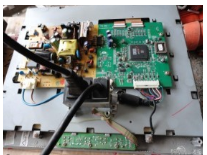1. How to calculate the impedance of FPC?
Due to its unique advantages of lightness, thinness and compactness, FPC flexible boards are suitable for more and more fields. There are also many boards that need to assemble components or perform various signal transmissions, so the requirements for FPC impedance continue to increase.
Due to its unique advantages of lightness, thinness and compactness, FPC flexible boards are suitable for more and more fields. There are also many boards that need to assemble components or perform various signal transmissions, so the requirements for impedance continue to increase. There are generally four factors that affect impedance. 1), DK value. 2) The thickness of copper. 3) Copper traces and space. 4), the thickness of the dielectric layer (PI & coverlay).
Er1: The DK value of the substrate, the DK value of different brands of materials and thickness is different, the normal range is 3.15~4.2
T1: The thickness of copper, this is the thickness of the finished copper, marked as 30um in the table below, which means that the base copper thickness will be around 18um.

W1: copper trace width, S1 is copper trace space. The width and space of the trace are important for impedance.
H1: The thickness of the dielectric layer, that is, the thickness of the PI of the substrate, and the thickness of the adhesion between the thickness of the PI and the adhesive material.
W1&S1: The width and space of copper.
C1 / C2 / C3: Covering layer thickness. The 1/2 mil covering layer is 28um, and the 1mil covering layer is 50um.
CEr: The DK value of the cover layer, the 1/2 mil cover layer is 2.45, and the 1 mil cover layer is 3.4
Usually, customers need impedance value and total board thickness (stacking). So, what should we do to meet the impedance required by customers?
The first step is to adjust the copper traces and spacing to meet the impedance. The smaller the trace width, the greater the impedance. Our minimum copper trace and spacing is 2mil. If the impedance requirement is still not met when the copper trace is adjusted to 2mil, then the second step must be continued.
The second step, usually the reference layer of impedance is copper foil, we can change the copper foil to grid copper, because the greater the grid spacing, the greater the impedance value.
In the third step, if the above two steps still cannot meet the impedance requirements after adjustment, we need to communicate with the customer to adjust the laminate, including the thickness of the copper, the thickness of the dielectric layer and the thickness of the cover layer.
2. What is the reason for the residual copper after FPC etching?
The raw material for making FPC soft board, the material is rolled before cutting, and the copper is a whole, and the finished FPC we often see is based on the designed circuit diagram, then how to keep the circuit diagram we need On the substrate, it is actually done by etching. The reason for the residual copper after etching.
The raw material for making FPC soft board, the material is rolled before the material is cut, the copper is a whole, and the finished FPC we often see is based on the designed circuit diagram, then how to keep the circuit diagram we need On the substrate, it is actually done by etching. The etching is evenly sprayed on the surface of the copper foil through the nozzle under a certain temperature condition (45+5) etching solution, and there is no etching resist protection The copper undergoes an oxidation-reduction reaction, and the unnecessary copper is reacted, and the substrate is exposed and the circuit is formed after stripping. The main components of the etching solution: copper chloride, hydrogen peroxide, hydrochloric acid, soft water (the solubility is strictly required).
1. Reasons for residual copper after etching:
1. The developing is not clean (there is residual dry film in the area corresponding to the residual copper), do a copper chloride test.
2. The corresponding area of the film is transparent. You can first check whether the film is in good condition and the line is neat.
2. Remaining copper appears after etching to improve methods:
1. If it is the overall residual copper, start from the etching section, mainly from the etching section, the temperature and concentration of the etching solution, and the pressure of the nozzle, whether there is nozzle blockage, it is recommended to test whether the etching breakpoint is too far behind, and the copper is facing down Conducive to the bite corrosion of copper.
2, the residual copper of the line spacing is also related to the selection of the dry film
3. If it is part of the residual copper, start with the exposure and development section
4. Specific analysis of specific problems, targeted analysis of the residual copper situation of flexible circuit boards, and flexible adjustment of the production process of FPC flexible circuit board etching.